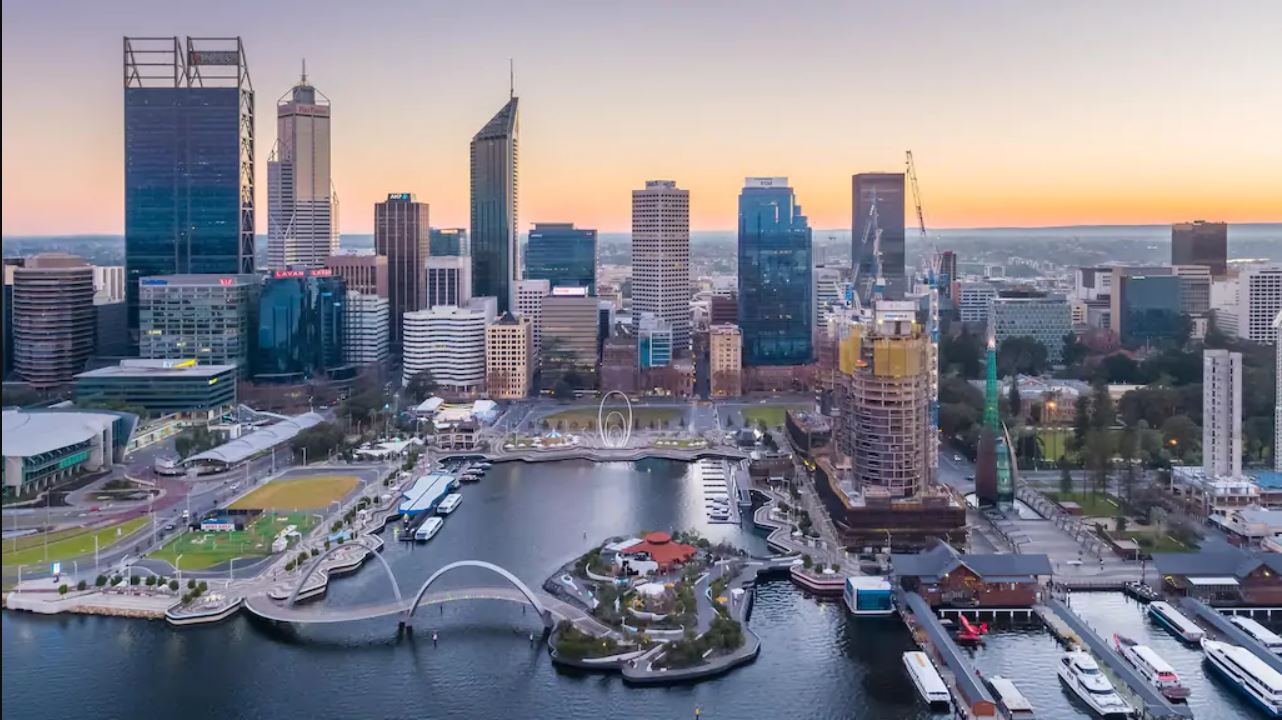Tuesday, 23 April 2019 8:04AM
Instead, we just kept on building. Hipster restaurants and entertainment districts sprang up in forgotten places while thousands of extra hotel rooms — 3807 to be exact — introduced competitive rates.
Trendy student sky-rises helped to fill out Perth, as did a network of new apartments, small bars, funky co-working spaces, public boulevards and some extra schools and hospitals for the masses.
Cosmopolitan festivals, new retail precincts and a world-class stadium added to the city’s liveability, and then the ultimate test was put in place: direct international flights into WA’s renovated airports.
And now — having built it — we must wait with bated breath to see if they come.
So far, the response has been mixed.
On the one hand, entrepreneurs have heeded Perth’s call, with an extra 2000 small businesses added to the WA economy in the past financial year, according to the Australian Bureau of Statistics. But on the other, there is alarm at unemployment levels riding at an 17-year high of 6.8 per cent.
Last year, Perth’s population hit two million for the first time. The bad news, however, is that it comes on the back of a significant brain drain to the east coast, albeit at a slowing pace.
Fortunately, tourist numbers and conference dollars both grew 10 per cent in the year to September. Less fortunate is the 1.7 per cent reduction in the leisure market’s expenditure and WA’s failure to keep up with east coast tourism.
And while international student numbers have grown 20 per cent in the past decade, they have dropped 6 per cent over the past two years, with Perth again failing to keep pace with the east coast and its education juggernaut.
The mixed result is to be expected in the post-resources boom economy. But it is ironic given Perth has better infrastructure and is more liveable, vibrant, accessible and affordable than it was a decade ago, when hordes of businesses and skilled migrants flocked to the State for a piece of the resources boom action.
The Perth Convention Bureau is optimistic about post-boom Perth, claiming it has finally come of age as a business destination after shrugging off the dull image and a reputation for hefty prices.
The PCB, which has the task of promoting WA as a destination for organisations and corporations looking to book national and international conferences, meetings and incentive trips for staff, says the business events sector added $142 million to the State’s economy last financial year.
This was up $22 million on the year before, or an extra $423,000 a week.
PCB’s executive director of stakeholder relations, Nicolle Davey, says previous feedback at national, and sometimes international, trade shows was that Perth was very expensive and quiet.
“There was a belief that nothing was open past 8.30pm or 9pm and that there was nothing to do,” she says.
However, she says the message is spreading about Perth’s modernised licensing laws, night life and places to go, its exclusive shopping districts at Claremont Quarter and King Street, the nearby Swan Valley, as well as high-quality meeting and conference facilities at the Perth Convention and Exhibition Centre, Crown Towers, Optus Stadium and many of the city’s hotels.
“A more vibrant Perth with Elizabeth Quay, Yagan Square, Hibernian Place and our thriving small and laneway bars and festivals also means Perth has more to offer for activities and dining,” she says.
“Decisions of where to hold conferences are not only about the facilities and accommodation but are also very much about what delegates can do after hours.”
Davey says relatively new direct flights from London and China, confirmation of direct flights from Japan in October and discussions about direct flights from India had increased conference bookings from South-East Asia.
Importantly, she believes a key game changer is the vast range of hotels on offer, which are among the most competitive in Australia.
Figures from the Australian Hotels Association show just over 3800 hotel rooms were added at 34 hotels or serviced apartments since 2012. A further 2742 rooms in 14 hotels or serviced apartments are significantly committed or under construction, and there are proposals for 5362 more rooms in 40 hotels or serviced apartments.
Pan Pacific Perth general manager Rob Weeden says there is no doubt that occupancy and rates have fallen since the heady days of the mining boom.
Occupancy dropped a couple of points last year to hit 77 per cent and prices dropped about one per cent in the same period. But prices have plummeted 15 per cent since 2012, when occupancy was running at 85 per cent.
Weeden is surprisingly confident about the future, even though he is faced with such extensive competition, claiming WA is in a good position to outshine its closest tourism competitors.
“I genuinely believe we are about to come into a purple patch,” he says.
“The exchange rate at 70 per cent means Australia and WA is at happy hour rates compared to American dollar and euro-pegged currencies.
“We are not competing with the Eastern States for short breaks out of South-East Asia but rather competing with the big regional cities like Singapore, Kuala Lumpur, Hong Kong and Macau.”
Weeden says the bigger challenge is attracting the east coast leisure market, and he blames airlines for the difficulty.
“I know it’s a yield game but we are being priced out of the game by our own carriers who also fly to (New Zealand, Pacific Islands and Asian) destinations,” he says.
“It’s amazing how many east coast Australians have never been to WA — when the airfares to Fiji are half the price for a family of four, that is a powerful alternate choice.”
Tourism Council chief executive Evan Hall says the key problem in attracting visitors is that the global masses simply don’t know about the State because Tourism WA is not marketing it as well as it should.
He is backed up by a 2017 Auditor General’s report that found the State lacked effective marketing strategies, despite Tourism WA spending $42 million of its $91 million budget on marketing.
The report also predicted Tourism WA would fall short of achieving its goal of getting $12 billion in visitor spending by 2020 by about $800 million a year, unless there are significant improvements.
Hall says the other key initiatives to attract visitors would be to revamp the Perth Convention and Exhibition Centre, which he first criticised as being outdated and too small about eight years ago.
WA’s key economic advantage always has been, and probably always will be, based on its resources.
While the resource sector downturn hit hard, Acil Allen economist John Nicolaou says the resource sector has already turned the corner.
The boost has not yet translated to other parts of the economy — but more on that later.
“The bad news is long gone,” Nicolaou says.
“Signs of recovery in the WA economy were evident three years ago, with the 2016 recovery in commodity prices, and miners are gearing up to invest both out of necessity and opportunity.
“Necessity, because they need to maintain production levels, and opportunity, because there are good opportunities in other mineral resources, like lithium.”
The green shoots in the sector are again attracting business from across the globe. Global asset advisory firm Gordon Brothers International recently set up in Perth, after noticing more than half the work flooding into its Sydney and Melbourne offices over the past 18 months came from Perth.
The company, which makes asset-based loans against plant equipment and heavy machinery, says demand was surging as local businesses got more opportunity to work.
The resurgence has been noted by the Australian Bureau of Statistics, which shows expenditure on equipment plant and machinery — which is often seen as a weather vane for the State’s economy — grew 30 per cent in the two years to last December.
Gordon Brothers director Ben Gibson says his WA clients, mostly in the mining and transport sectors, are battle-scarred after a couple of rough years but cautiously optimistic about the imminent future.
He says many of his clients can’t get finance through traditional avenues like banks and are turning to firms like Gordon Brothers as work picks up.
He cites BHP’s South Flank, Rio Tinto’s Koodaideri and Fortescue’s Eliwana iron ore projects as the big drivers in the plant and machinery sector.
“The demand for equipment is much better than it was a couple of years ago,” he says.
“Two years ago there was a whole lot of parked-up dump trucks around the outskirts of Perth and the Pilbara and they’ve all disappeared now and gone back to work, and we’ve noticed through auction sale results and private treaty sales that equipment prices are much better.”
The promise of green shoots raises the question about why we are not experiencing higher employment and consumer spending.
The jobs market is at a 17-year low and consumers are still holding the purse strings tightly. The housing market, as a result, continues to struggle.
In 2016-17, WA gross State product contracted for the first time since records began in 1989. The next year it limped ahead only slightly.
Chamber of Commerce and Industry WA chief economist Rick Newnham puts the problem down mainly to high wages and a payroll tax of up to 6.5 per cent.
“What’s making it really difficult is the cost of creating jobs here in WA,” he said.
“WA has historically high wages as a hangover from the resources boom and we’ve got the highest tax on jobs of any State in the country — payroll tax — which means it’s more expensive to create a job here compared to anywhere else in the country.
“When businesses look at the cost of creating jobs in WA, it might make them think twice about setting up their operations here.”
Acil Allen’s Nicolaou says it is WA’s restricted population growth which is a key factor in the sluggish economy.
“One of the critical enablers of economic growth has to be great population growth and historically this State has had above-average growth,” he says.
“What we’ve seen in last (few) years is that we had peak growth in 2013, growing above 3 per cent per annum — which from a population growth perspective is extraordinary.
“Since then it’s come off and it’s below one per cent.
“The numbers from natural births are steady, what we have seen is a lot less people coming from overseas and an exodus of people out of the State to other parts of the country to take advantage of opportunities.
“It has had an impact on the economy not growing as strongly as we expect it to be.”
The problem could continue well into the future, with research commissioned by the Committee for Perth showing that in 2016 there were 50 dependent children and adults for every 100 people of working age, but by 2100, the total dependants is set to increase to 79.5 per 100 people of working age.
FOR FULL STORY PLEASE CLICK THE LINK BELOW:
thewest.com.au/business/perth-is-open-for-business-so-whats-holding-us-back-ng-b881122703z


 RSS Feed
RSS Feed